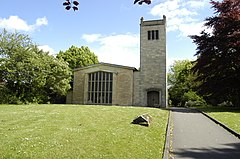Waddington, Lincolnshire
| Waddington | |
|---|---|
 St. Michael's Church, Waddington |
|
| Waddington shown within Lincolnshire | |
| Population | 6,122 (2011 Census) |
| OS grid reference | SK977644 |
| • London | 115 mi (185 km) S |
| Civil parish |
|
| District | |
| Shire county | |
| Region | |
| Country | England |
| Sovereign state | United Kingdom |
| Post town | LINCOLN |
| Postcode district | LN5 |
| Dialling code | 01522 |
| Police | Lincolnshire |
| Fire | Lincolnshire |
| Ambulance | East Midlands |
| EU Parliament | East Midlands |
| UK Parliament | |
Waddington is a large rural commuter village and civil parish in the North Kesteven district of Lincolnshire, England, situated approximately 4 miles (6 km) south of Lincoln on the A607 Grantham Road. The village is known for its association with RAF Waddington. At the 2001 Census Waddington had a population of 6,086, increasing to 6,122 at the 2011 census.
The village is a documented settlement in the Domesday Book of 1086 and was mainly an agricultural community until the late 19th century. Horseracing also took place on the heathland areas, which are now part of the RAF station. At various times other activities including malting, brick-making and stone-quarrying have taken place in the village.
Around 1830, George Boole, the mathematician, taught at Waddington Academy Boarding School in the village, run by Robert Hall. From 1838 to 1840, Boole lived in the village and became headmaster of the academy.
Enemy action during 1941 severely damaged 71 houses in the village, as well as the Horse & Jockey pub and the NAAFI building on the RAF station. The damage was mainly caused by two aerial mines; large bombs dropped by parachute and fused to explode before hitting the ground. Eleven people were killed, among them the NAAFI manageress, Mrs Constance Raven, after whom the All-Ranks Club on the RAF station is still named.
The village 12th-century church was destroyed in a Second World War air raid on the night of 8 May 1941. It was replaced by the present-day Anglican parish church of St Michael on High Street, a modern stone building consecrated in 1954.
...
Wikipedia

